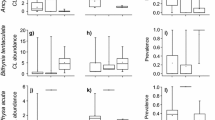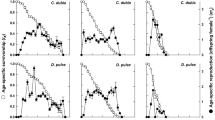Abstract
We tested the reciprocal effects of water conditioned by exudates of Aeolosoma sp. (Aphanoneura, Oligochaeta) and fish (Skiffia lermae: Goodeidae) and by the presence of Aeolosoma sp. on the population dynamics of four species of anomopod cladocerans (C. cornuta, C. dubia, S. serrulatus and S. vetulus) at 25 °C for 26 days using Chlorella vulgaris(1 × 106 cells ml−1) as a basic food for all. We found that, regardless of treatment, C. cornuta and C. dubia had a long initial phase of slow growth, followed by a rapid increase after the second week and that, regardless of treatment, C. dubia had a higher rate of population increase per day than C. cornuta. S. vetulus had a longer lag phase than S. serrulatus. Fish-conditioned water resulted in growth inhibition in S. serrulatus, but had no effect on S. vetulus, while Aeolosoma-conditioned water inhibited growth of S. vetulus but not that of S. serrulatus. Our results suggest a scale of responses of cladocerans to exposure to fish- and worm-conditioned water and to the presence of worms, ranging from a mild stimulation to no effects to inhibited growth. Kairomone-effects on body size of C. cornuta were not significant, but beak length was strongly influenced, and more by fish than by worm kairomones. In S. vetulus, differences in size were not significant. However, individuals grown in the presence of worms had higher biomass while those grown in the presence of fish and worm kairomones showed a decreased weight. Effects of worm exudates and of their live biomass on cladocerans were thus opposite in Simocephalus. In Ceriodaphnia dubia, in contrast, they were additive. Aeolosoma was depressed by all four cladocerans, although worms tried to penetrate the valves of the cladocerans to feed on the tissue inside. In doing so, they suffered significant casualties, especially from blows of the powerful post-abdomen of Simocephalus. The nature of the cladoceran-worm interaction is therefore far from simple: in addition to the 'chemical communication' that is present, it has a predatory component (worms trying to feed on cladocerans) but the reverse might also be true (cladocerans filtering out tissues of disrupted Aeolosoma). Since both worms and cladocerans feed on algae, exploitative competition also seems to be involved. In this, the worms appear to be the inferior partner, although none of the experiments lasted long enough to drive any of the competing partners to extinction.
Similar content being viewed by others
References
Alva-Martínez, A. F., S. S. S. Sarma & S. Nandini, 2001. Comparative population dynamics of three cladoceran species (Cladocera)in relation to different levels of Chlorella vulgaris and Microcystis aeruginosa. Crustaceana 78: 749-764.
Anonymous, 1985. Methods of measuring the acute toxicity of effluents to freshwater and marine organisms. US Environment Protection Agency EPA/600/4-85/013.
Barea-Arco, J., C. Pérez-Martínez & R. Morales-Baquero, 2001. Evidence of mutialistic relationship between an algal epibiont and its host, Daphnia pulicaria. Limnology Oceanography 46: 871-881.
Borowitzka, M. A. & L. J. Borowitzka, 1988. Micro-algal Biotechnology, Cambridge University Press, London.
Brinkhurst, R. O. & S. R. Gelder, 2001. Annelida:Oligochaeta, including Branchiobdellidae. In Thorp, J. H. & A. P. Covich (eds), Ecology and Classi cation of North American Freshwater Invertebrates, 2nd edn. Academic Press, New York: 431-463.
Connaughton, V. P., A. Schuur, N. M. Targett & C. E. Epifanio, 1994. Chemical suppression of feeding in larval weak sh (Cynoscion regalis) by trochophores of the serpulid polychaete Hydroides dianthus. Journal of Chemical Ecology 20: 1763-1772.
Downing, J. A. & F. H. Rigler (eds), 1984. A Manual for the Methods of Assessment of Secondary Productivity in Fresh Waters, 2nd edn. IBP Handbook 17. Blackwell Scientific Publ., London.
Dumont, H. J. & I. Carels, 1987. Flatworm predator (Mesostoma cf lingua) releases a toxin to catch planktonic prey (Daphnia magna). Limnology and Oceanography 32: 699-702.
Dumont, H. J. & S. Negrea, 2002. Introduction to the Class Branchiopoda, Backhuys, Leiden, 397 pp.
Dumont, H. J. & I. Van de Velde, 1976. Some types of headpores in the Cladocera as seen by scanning electron microscopy and their possible functions. Biologisch Jaarboek Dodonaea 44: 135-142.
Dumont, H. J., S. S. S. Sarma & A. J. Ali, 1995. Laboratory studies on the population dynamics of Anuraeopsis fissa (Rotifera) in relation to food density. Freshwater Biology 33: 39-46.
Fonseca, C. P., J. G. Tundisi, T. Matsumura-Tundisi & O. Rocha, 1990. Predation on and by pelagic Turbellaria in some lakes in Brazil. Hydrobiologia 198: 91-101.
Hellsten, M., R. Lagergren & J. Stenson, 1999. Can extreme morphology in Bosmina reduce predation risk from Leptodora? An experimental test. Oecologia 118: 23-28.
Iyer, N. & T. R. Rao, 1993. Effect of the epizoic rotifer Brachionus rubens on the population growth of three cladoceran species. Hydrobiologia 255/256: 325-332.
Jeffries, M., 1988. Individual vulnerability to predation: the effect of alternative prey types. Freshwater Biology 19: 49-56.
Juergens, K., O. Skibbe & E. Jeppesen, 1999. Impact of meta-zooplankton on the composition and population dynamics of planktonic ciliates in a shallow, hypertrophic lake. Aquatic Microbial Ecology 17: 61-75.
Krebs, C. J., 1985. Ecology: the Experimental Analysis of Distribution and Abundance, 3rd edn. Harper & Row, New York.
Lazarro, X., 1987. A review of planktivorous shes:their evolutions, feeding behaviours, selectivities and impacts. Hydrobiologia 146: 97-167.
Nandini, S. & S. S. S. Sarma, 2000. Zooplankton preference by two species of freshwater ornamental fish larvae. Journal of Applied Ichthyology 16: 273-275.
Nandini, S. & S. S. S. Sarma, 2002. Competition between Moina macrocopa and Ceriodaphnia dubia: a life table demography study. International Review of Hydrobiology 87: 85-95.
Nandini, S. & S. S. S. Sarma, 2003. Population growth of some genera of cladocerans (Cladocera) in relation to algal food (Chlorella vulgaris) levels. Hydrobiologia 491: 211-219.
Nandini, S. & S. S. S. Sarma, 2004. Effect of Aeolosoma sp. (Aphanoneura: Aeolosomatidae) on the population dynamics of selected cladoceran species. Hydrobiologia 526: 157-163.
Nandini, S., S. S. S. Sarma & M. D. Hurtado-Bocanegra, 2002. Effect of four species of cladocerans (Crustacea) on the population growth of Brachionus patulus (Rotifera). Acta Hydrochimica; Hydrobiologetca 30: 101-107.
Pennak, R. W., 1978. Freshwater Invertebrates of the United States, Wiley, New York.
Smirnov, N. N., 1992. The Macrothricidae of the World. Guides to the Identi cation of the Microinvertebrates of the Continental Waters of the World, SPB Academic Publishing, The Netherlands.
Sokal, R. R. & F. J. Rohlf, 2000. Biometry, W. H. Freeman and Company, San Francisco.
Spencer, M., L. Blaustein, S. S. Schwartz & J. E. Cohen, 1999. Species richness and the proportion of predatory animal species in temporary freshwater pools: relationships with habitat size and permanence. Ecology Letters 2: 157-166.
Tollrian, R. & C. D. Harvell (eds), 1998. The Ecology and Evolution of Inducible Defenses, Princeton University Press, Princeton, NJ.
Weber, A. & S. Declerck, 1997. Phenotypic plasticity of Daphnia life history traits in response to predator kairomones: genetic variability and evolutionary potential. Hydrobiologia 360: 89-99.
Author information
Authors and Affiliations
Rights and permissions
About this article
Cite this article
Sarma, S.S.S., Dumont, H.J. & Nandini, S. Interactions between the Anomopod Cladocerans Ceriodaphnia Dubia, C. Cornuta, Simocephalus Vetulus and S. Serrulatus, the Aphanoneurid Worm Aeolosoma sp., and the Fish Skiffia Lermae: Predation or Competition, or Both?. Hydrobiologia 526, 147–156 (2004). https://doi.org/10.1023/B:HYDR.0000041608.15608.93
Issue Date:
DOI: https://doi.org/10.1023/B:HYDR.0000041608.15608.93




